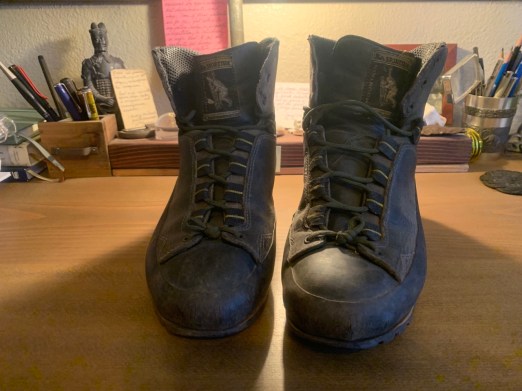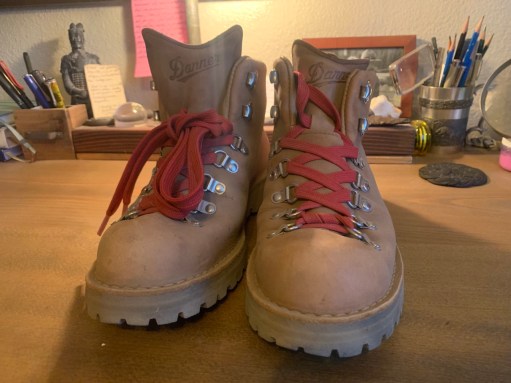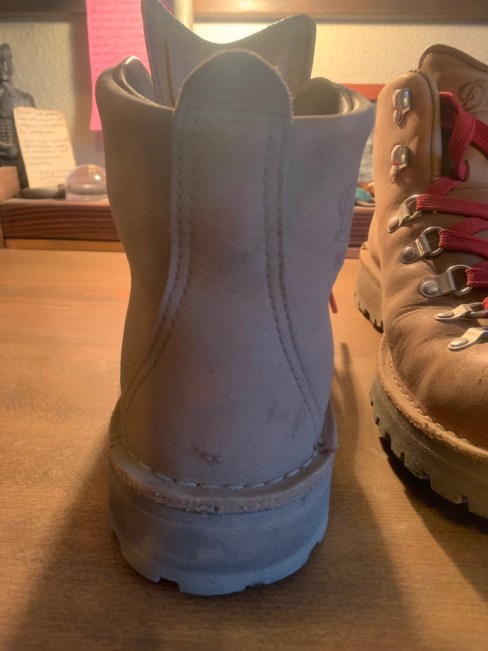The foundation of all hiking forays or backpacking adventures into the wilderness is your feet. Thus equipment decisions should start with a good pair of shoes.
What I’m Not Using & Why
I’ve never hiked in sandals for fear my ankles won’t be up to muster. I used to conduct day patrol of wilderness areas around Tuolumne Meadows in Yosemite National Park. Then I preferred Solomon trail running shoes. On the Appalachian Trail in the early nineties, I went through three different pairs of shoes, now not worth mentioning.
In the Wind River Range and in Glacier National Park, I’ll be hiking over rough, uneven terrain, including some off trail. I’ll be carrying around 35 pounds of food, water, and camping gear. There’s also some opportunity for ‘peak-bagging’ along the way. Therefore I’ll be wearing a study pair of boots.
My Wesco 10 inch, ‘roughout’ fire boots served me well for 12 years of fire investigations.

Before that it was a pair of 8″ Whites fire boots, which I wore on duty, so polished to a high shine before every shift.

The Whites were originally light camel-brown. I stripped and redyed them to cordovan–the Park Service uniform standard. In 2009 I repeated the process to black, so to match the US Forest Service uniform standard.
These boots were great in that they made me look taller (ha!) and firefighters always look at and judge a person by their boots, or lack there of… First they saw that I could suffer in these heavy, unnecessarily high-heeled monstrosities. Then they could make fun of me for not working hard because my boots were shiny! Respect and self deprecation all in one glance!
But traditional fire boots, with a ‘logger’s heel’–no matter what some 20-year, grizzled Hot Shot Superintendent might try to tell you–are NOT built for long, multi-day hiking. Nor are they suited for mountaineering of any sort. (I’ll do another post rant debunking the myths of how great fire boots are.)
I have an old pair of La Sportiva’s “Trango 2.” I got these secondhand from a friend that was upgrading their kit and didn’t like the feel of these.

Having a very stiff metal shank for crampons, a wedge- raised heel to help keep your weight above your toe points, and a smaller toe box to help with toeing in on rock, these boots are designed for mixed, alpine rock and ice climbing. You could (and I have) used them for the approach to and descent from ice climbs. I have also used them in one-day assaults and reclamations of illegal cultivation sites. Bottom line, my feet are ‘dog tired’ after hiking in them all day.
So What Then?
I’m left with a decision between my La Sportiva Karakorums or my Danner Mountain Lights. Why am I still debating these two? Let’s look at the pros and cons of each.
La Sportiva Karakoram
The La Sportiva website describes the Karakorams as a
“versatile mountaineering and backpacking boot perfect for light-duty mountaineering, heavy-duty hiking and backpacking or various types of outdoor work situations where you need durable support and all-day comfort.”
https://www.lasportivausa.com/karakorum.html

It was for “outdoor work situations where you need durable support and all-day comfort” that I got them. La Sportivas have always fit me well. I was aware that some Forest Service Smoke Jumpers have been using a similar boot–the “Glacier WLF”–to hike out pf the deep wilderness areas they are dropped into. The Glacier WLF is insulated (bad, more on that in a minute). They are built on the “Makalu” last, similar to the old Trango 2 (good). They have a nylon shank (more flexible for hiking, not quite stiff enough for ice climbing, also good). The Makulu is also insulated (bad). The Karakorams are not insulated (good) and also built on the Makalu last (yay!).
SIDEBAR: why is ‘insulated’ bad?
Reynaud’s Syndrome, maybe, sort of, or maybe not…
My feet sweat a lot–hyperhydrosis. And due to a previous mistreatment of ‘frost nip’–yes, that’s a real thing–I have poor circulation in my toes. In even warm climates my feet get moist from perspiration overwhelming the socks’ ability to transport moisture. My toes respond by clamping down what little bit of capillaries I do have there. Then my toes go cold and will stay that way until I change socks and rewarm them. If the boot is damp, i usually need to change them too. All the insulated boots I have ever used seem to make this problem more profound. They seem to decrease breathability and hold more moisture, the insulation acting as a perspiration sponge.
Work and play on the west side of the Sierras and the foothills is hot and dry, and rarely am I all day in cold wet snow. In those conditions I usually wear pack boots (I love my Sorels for this) and carry extra socks and felt liners.
By the way, my experience has been “GoreTex” liners create a similar problem.
My Experience With the Karakorams
I’ve had the Karakorams for about six years now with only one problem. The first time I wore them was in wet conditions and the right book leaked. I was working an over-the-snow ‘poker run’ checkpoint … in the rain … which was melting the snow that otherwise covered the asphalt. It was like I was standing with one foot in a bathtub for several hours before I was able to change them out. I swapped them out for my Sorels and fresh socks–always in my patrol vehicle winter clothing kit.
When I got a chance to troubleshoot them I discovered several locations were the sole was not glued to the rubber rand. My local cobbler (more about Arsen later) fixed the problem with fresh glueing. I haven’t had a problem with them since.
All day repetitively walking up and down steep, sometimes terraced, rugged terrain, wearing up to 20 pounds of gear, and choping, stacking, and dragging… and nary a hot spot. Tough, durable leather, with a semi-flexible nylon shank, needed zero break-in. I haven’t experienced any ‘bite.’
One downside is weight. A solid four pounds a pair, so two pounds per foot. According to this article over at Mountain Tactical Institute, one pound on your feet equals five pounds on your back. Which in turn equates to five percent more energy expended. Its a trade off you should be aware of.
What About Those Danner Mountain Lights?
First of all they are gorgeous aren’t they? Classic single piece of leather in “Clovis” tan with a stitched down ‘Norwegian welt’ construction. And that pop of red in the laces? Wow! I’m serious–in an old-school mountaineering sense these are sexy. Speaking of laces, Danner provides both flat (my preference) and round laces with your purchase.

Though I’ve only had these for two years and haven’t used them much, the construction and leather, backed by Danner’s over 90 year history of making boots, I’m certain they would be durable for many a hike … if …
But herein lies the rub. So far on every training hike in these boots, from three miles to ten, with a fifty pound training load, I’ve ended up with blisters on both feet in the most curious of locations–that narrow land between the ball or forefoot and the first toe joints.
But before I got far enough to get blisters I was having another problem. I was experiencing boot bite on my Achilles tendon on both feet/legs–where the top of the ankle cuff met the tendon. Though well padded, and despite thick socks, and even when leaving the top hook-style eyelet undone I got boot bite.

See that strip on leather going down the heel? And that seam of rolled double leather at the top?

This seems to be creating the problem–multiple pieces leather and layers of stitching.
Googling the problem led to an unexpected solution at Boyers Boot-N-Shoe’s “Ask the Boot Guy” blog. Try “breaking them in with a baseball bat!” This actually did work with one boot but not so much with the other. And I ran out of leather conditioner.
I went back to “Georgio and Son’s Botega” to show the problem to Arsen Sheklian. Arsen said, “leave them with me; I have the perfect tool.” Enter the “Warnco Rol-Eze Model AW.”

… A week later I picked up the boots and that afternoon hiked about five miles. The bite was all gone.
Now back to those curiously located blisters…
Here I learned they are “distal forefoot blisters” (duh). Apparently, “weight bearing forces in the [ball of the foot] push the blister fluid to the mush less weight bearing [distal] area.” So, I need to focus my prevention on the ball of the foot.
I’ve put “Engo Blister Patches” inside the boots.

I wear a double sock system, and I have been greasing up the offending area of the foot with Body Glide [pic]. I’ve also been applying rubbing alcohol to the soles of my feet (not too much too often or they will dry out and crack, yikes!). And walking around barefoot as much as possible to build some callouses.
So far I’m still getting blisters. But here’s something,
“there are more sweat glands on the sole of the foot compared to other areas and this contributes to high friction levels.
“It’s warm and humid in your shoe. That means high friction levels–things are clammy and sticky.”
Rebecca Rushton, BSc(Pod)
Remember when I mentioned my dislike for insulation? The Mountain Lights aren’t insulated (according to Danner’s website). But they are ‘GoreTex’ lined. The GoreTex liner has proven to be not breathable in the hot and dry temperatures I’m training in. I should have bought the non-GoreTex version.
Single piece leather construction, with a leather liner or no liner, treated well with “Sno-Seal” or Hubbard’s Shoe Grease (my favorite) is inherently water-resistant and breathable.
Indeed, carrying less weight and slowing my pace can also reduce blister potential. I might also try foot powder to help keep my feet dry.
The Verdict
I am going to take the Mountain Lights for day hikes in Glacier National Park. But unless I can correct my mistake of purchasing GoreTex lined Mountain Lights in the next several weeks, I’ll be trudging through the Wind River Range in my trusty La Sportiva Karakorams.
